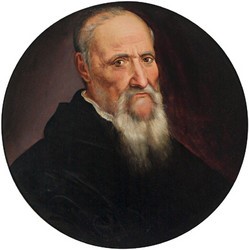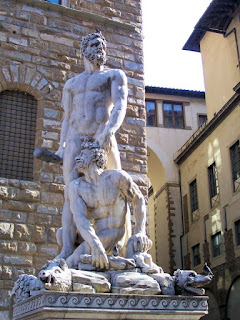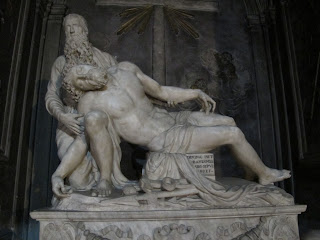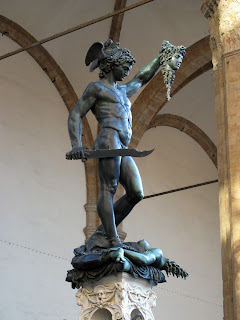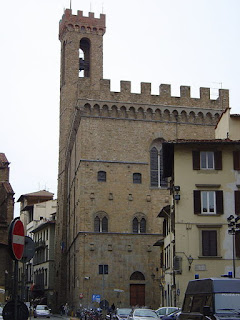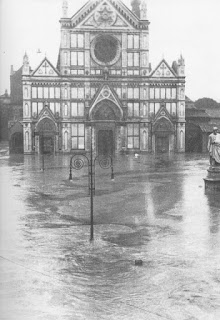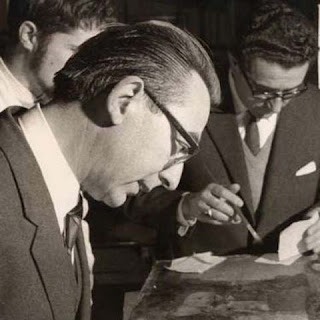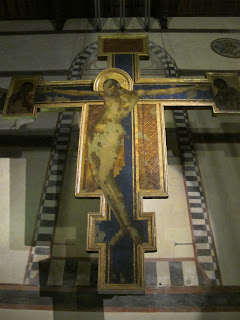Creator of the famous Perseus bronze had a dark history
| Cellini's bronze of Perseus with the Head of Medusa in Piazza della Signoria in Florence |
The colourful life of the Renaissance artist Benvenuto Cellini
ended on this day in 1571 with his death in Florence at the age of 70.
A contemporary of Michelangelo, the Mannerist Cellini was
most famous for his bronze sculpture of Perseus with the Head of Medusa, which
still stands where it was erected in 1554 in the Loggia dei Lanzi of the Piazza
della Signoria in Florence, and for the table sculpture in gold he created as a
salieri - salt cellar - for Francis I of France.
The Cellini Salt Cellar, as it is generally known, measuring 26cm (10ins) by 33.5cm (13.2ins), is now
kept at the Kunsthistorisches Museum in Vienna, with an insurance value of $60
million.
His works apart, Cellini was also known for an eventful personal
life, in which his violent behaviour frequently landed him in trouble. He killed
at least two people while working in Rome as a young man and claimed also to
have shot dead Charles III, Duke of Bourbon, during the 1527 Siege of Rome by
mutinous soldiers of the Holy Roman Emperor, Charles V.
Cellini was also imprisoned for alleged embezzlement of the
gems from the tiara of Pope Clement VII, famously escaping from jail at the
Castel Sant’Angelo by climbing down a rope of knotted bedsheets, and for
immorality.
He was a self-confessed bisexual, being found guilty of
sodomy on a number of occasions. One
such charge, brought following accusations made by a male apprentice in his
Florence workshop, led to a prison sentence of four years, commuted to house
arrest following the intervention of the Medici family.
 |
| Cellini's extraordinary salt cellar in gold is insured for a value of $60 million |
Much of this is known because Cellini documented his life in
an autobiography, the first by a significant Renaissance figure, in which he shared
the details of his racy exploits.
Cellini was apprenticed as a metalworker in the studio of
the Florentine goldsmith Andrea di Sandro Marcone. He might have stayed in
Florence had he not twice had to leave to escape the consequences of his
violent behaviour.
After fleeing to Rome, he worked for the bishop of
Salamanca, Sigismondo Chigi, and Pope Clement VII, which is how he came to
participate on the side of the pontiff in defending Rome against the imperial
forces in 1527, where he claimed not only to have killed Charles III of Bourbon
but also to have shot, possibly fatally, the Prince of Orange, Philibert of
Chalon.
Having survived the sack of Rome, he returned to Florence
and in 1528 worked in Mantua, making a seal for Cardinal Gonzaga, which is now
the property of the city’s Episcopal Archives.
Back in Rome, he then executed several works in gold for Clement VII,
although apart from two medals made in 1534, which can be seen at the Uffizi in
Florence, none survive.
His violent ways continued. After his brother, Cecchino, had
killed a corporal of the Roman Watch and in turn received fatal wounds from the
gun of another soldier, Cellini meted out his own justice by murdering his
brother’s killer. He later murdered another man, this time a rival goldsmith.
 |
| A portrait bust of Cellini by Raffaello Romanelli can be found on Florence's Ponte Vecchio |
Amazingly, he was absolved by Clement VII’s successor, Pope
Paul III, but the following year, having wounded a notary, he fled from Rome
and settled back in Florence.
He made his first visit to France as a guest of Francis I in
1538. It was two years later that he arrived at Fontainebleau, carrying with
him an unfinished salieri, which he had originally offered to Cardinal Ippolito
d’Este of Ferrara, and which he now completed in gold for the French king. The piece,
which has the figures of a man and a women symbolising the sea and the Earth, and in which tiny models of a ship and a temple were intended to be receptacles for the condiments, is the only surviving fully authenticated Cellini work in precious metal. Modelled
by hand rather than cast, it has been dubbed the Mona Lisa of small sculptures.
While in France, Cellini modelled and cast his first
large-scale work, a large bronze lunette of the Nymph of Fontainebleau for the
entrance to the Louvre.
He left Paris to return to Florence in 1545, at which point
he was welcomed by Cosimo de’ Medici and entrusted with the commissions for the
bronze Perseus in the Loggia dei Lanzi, and for a colossal bust of the Grand
Duke of Tuscany, now at the Bargello museum, a short distance away.
Cellini’s other late works include his marble figures of
Apollo and Hyacinth (1546) and of Narcissus (1546–47), which are also in the
Bargello, as is a small relief of a greyhound made as a trial cast for the
Perseus (1545).
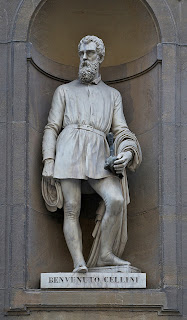 |
| There is a statue of Cellini in the Piazzale degli Uffizi |
After the unveiling of the Perseus, he began work on a
marble crucifix originally intended for his own tomb in the Florence church of
Santissima Annunziata, but now in the church of the royal monastery of the
Escorial in Spain.
He began to write his autobiography in 1558 and completed it
in 1562, dictating the text to an assistant in his workshop.
First printed in Italy in 1728, the book was translated into
English in 1771. Composed in colloquial language, it is enormously valuable in
providing a first-hand account of life in Clement VII’s Rome, the Paris of
Francis I, and the Florence of Cosimo de’ Medici.
 |
| Michelangelo's David (left) and Bartolommeo Bandinelli's Hercules and Cacus in Florence's Piazza della Signoria |
Florence’s Piazza della Signoria, situated right in the
heart of the city, close to the Duomo and the Uffizi Gallery, is home to a series
of important sculptures, including Giambologna’s The Rape of the Sabine Women
and his Equestrian Monument of Cosimo I, Baccio Bandinelli’s Hercules and
Cacus, the Medici Lions by Fancelli and Vacca, The Fountain of Neptune by
Bartolemeo Ammannati, copies of Donatello’s Judith and Holofernes and Il
Marzocco (the Lion), and the copy of Michelangelo’s David, at the entrance to
the Palazzo Vecchio.
As well as works by Cellini, other great Renaissance
sculptures can be appreciated in the Museo Nazionale del Bargello - the
Bargello National Museum - situated just a short distance from Piazza della
Signoria in Via del Proconsolo. The museum houses masterpieces by Michelangelo,
Donatello, Giambologna, Vincenzo Gemito, Jacopo Sansovino, Gianlorenzo Bernini
and many works by the Della Robbia family.
More reading:
Also on this day:
(Picture credits: Perseus statue by Denise Zavala; Cellini Salt Cellar by Jerzy Strzelecki; Romanelli bust by Grzegorz Gołębiowski; Uffizi statue by Jebulon; Piazza della Signoria statues by Richard White; Palazzo Bargello by Kandi; all via Wikimedia Commons)

